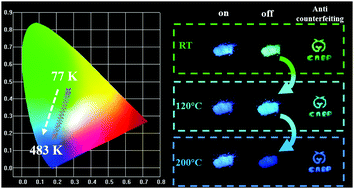Temperature-responsive conversion of thermally activated delayed fluorescence and room-temperature phosphorescence of carbon dots in silica†
Abstract
Afterglow including thermally activated delayed fluorescence (TADF) and room-temperature phosphorescence (RTP) has stimulated considerable attention owing to bright potential applications in optoelectronic devices, sensing, and security systems. However, previously reported afterglow materials are mostly single-mode (one of RTP or TADF only), a tunable multi-mode afterglow emission is still rarely achieved. Herein, we report the temperature-responsive conversion characteristics of TADF and RTP of carbon dots in silica (CDs@SiO2) for the first time. The unique temperature-responsive afterglow characteristics, that is, phosphorescence and TADF can be mutually transformed as the temperature changes, resulting in the free conversion of the RTP/TADF ratio as well as the afterglow color change through simple temperature control. The Si–O network plays multiple roles to strengthen and confine the embedded CDs, thus resulting in ultralong RTP emission and unique afterglow characteristics. Furthermore, CDs@SiO2 exhibited excellent stability against water, acid, alkali, salt and oxidants as well as polar solvents. CDs@SiO2 with unique afterglow characteristics and high stability can have multiple potential applications in rapid fingerprint detection and temperature sensing, especially in advanced temperature-responsive multicolor anti-counterfeiting and encryption.



 Please wait while we load your content...
Please wait while we load your content...